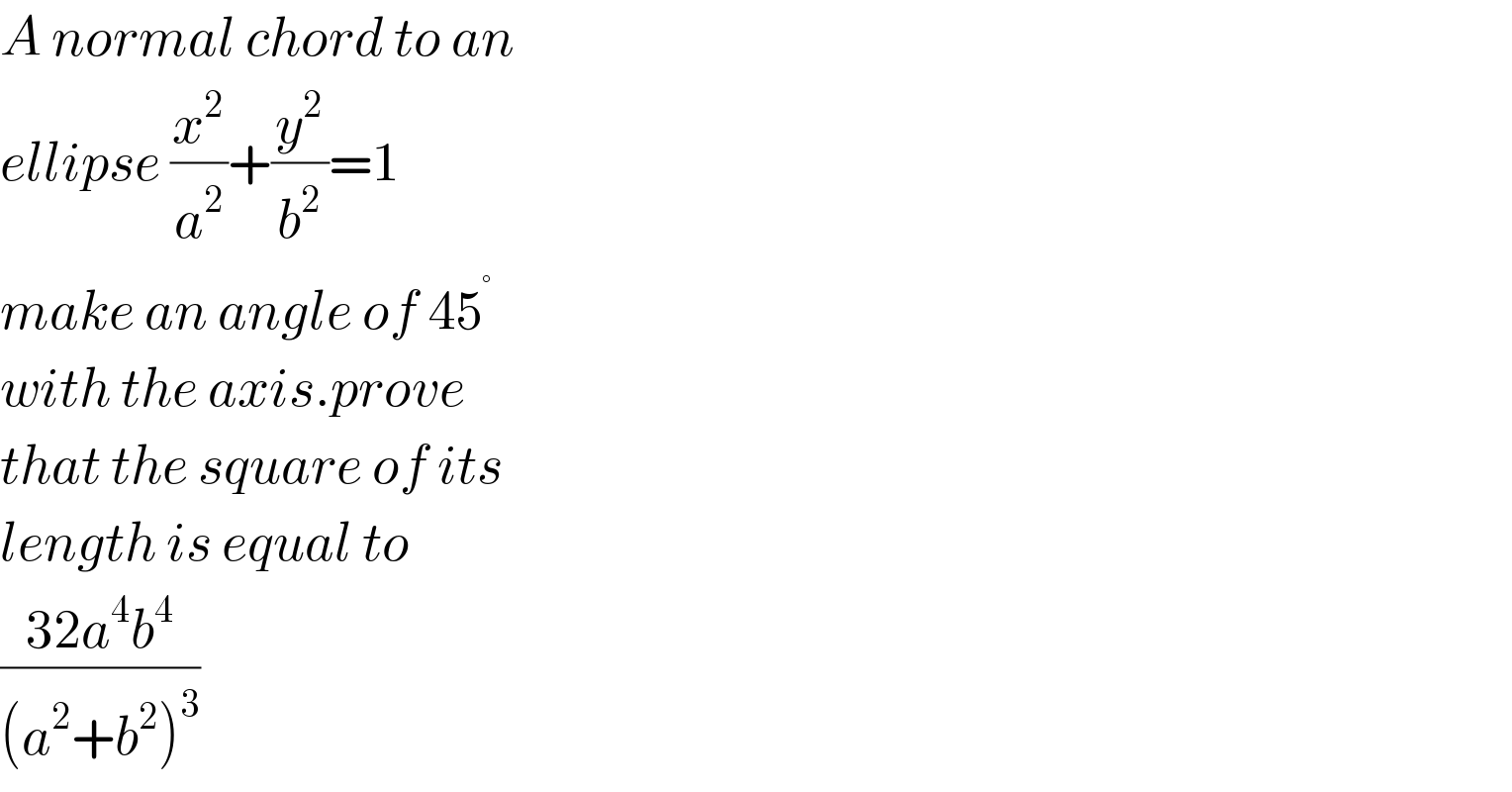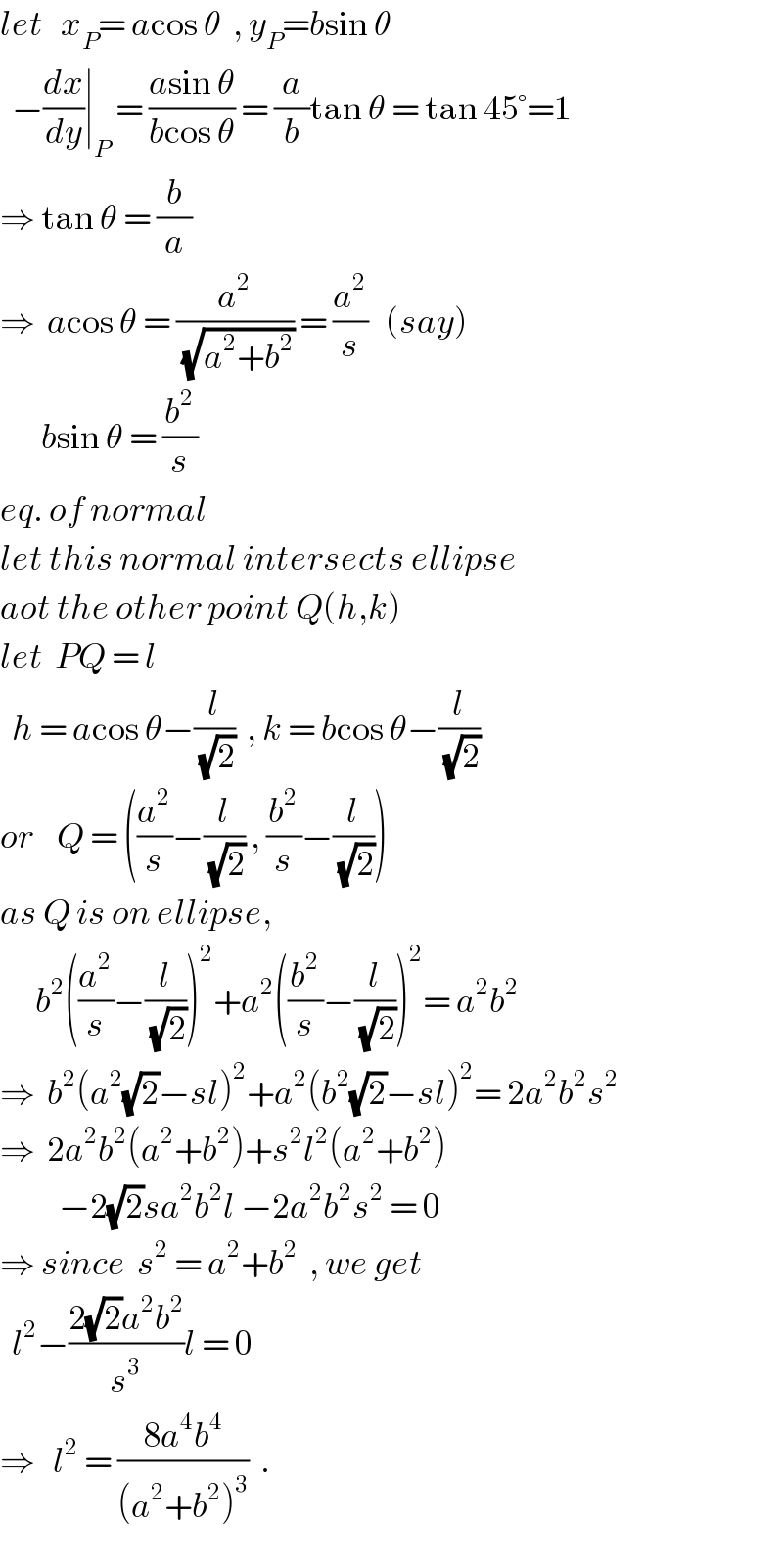
Question Number 51921 by peter frank last updated on 01/Jan/19

$${A}\:{normal}\:{chord}\:{to}\:{an}\: \\ $$$${ellipse}\:\frac{{x}^{\mathrm{2}} }{{a}^{\mathrm{2}} }+\frac{{y}^{\mathrm{2}} }{{b}^{\mathrm{2}} }=\mathrm{1} \\ $$$${make}\:{an}\:{angle}\:{of}\:\mathrm{45}^{°} \\ $$$${with}\:{the}\:{axis}.{prove} \\ $$$${that}\:{the}\:{square}\:{of}\:{its}\: \\ $$$${length}\:{is}\:{equal}\:{to} \\ $$$$\frac{\mathrm{32}{a}^{\mathrm{4}} {b}^{\mathrm{4}} }{\left({a}^{\mathrm{2}} +{b}^{\mathrm{2}} \right)^{\mathrm{3}} }\: \\ $$
Answered by ajfour last updated on 01/Jan/19

$${let}\:\:\:{x}_{{P}} =\:{a}\mathrm{cos}\:\theta\:\:,\:{y}_{{P}} ={b}\mathrm{sin}\:\theta \\ $$$$\:\:−\frac{{dx}}{{dy}}\mid_{{P}} \:=\:\frac{{a}\mathrm{sin}\:\theta}{{b}\mathrm{cos}\:\theta}\:=\:\frac{{a}}{{b}}\mathrm{tan}\:\theta\:=\:\mathrm{tan}\:\mathrm{45}°=\mathrm{1} \\ $$$$\Rightarrow\:\mathrm{tan}\:\theta\:=\:\frac{{b}}{{a}} \\ $$$$\Rightarrow\:\:{a}\mathrm{cos}\:\theta\:=\:\frac{{a}^{\mathrm{2}} }{\sqrt{{a}^{\mathrm{2}} +{b}^{\mathrm{2}} }}\:=\:\frac{{a}^{\mathrm{2}} }{{s}}\:\:\:\left({say}\right) \\ $$$$\:\:\:\:\:\:\:{b}\mathrm{sin}\:\theta\:=\:\frac{{b}^{\mathrm{2}} }{{s}} \\ $$$${eq}.\:{of}\:{normal}\: \\ $$$${let}\:{this}\:{normal}\:{intersects}\:{ellipse} \\ $$$${aot}\:{the}\:{other}\:{point}\:{Q}\left({h},{k}\right) \\ $$$${let}\:\:{PQ}\:=\:{l} \\ $$$$\:\:{h}\:=\:{a}\mathrm{cos}\:\theta−\frac{{l}}{\sqrt{\mathrm{2}}}\:\:,\:{k}\:=\:{b}\mathrm{cos}\:\theta−\frac{{l}}{\sqrt{\mathrm{2}}} \\ $$$${or}\:\:\:\:{Q}\:=\:\left(\frac{{a}^{\mathrm{2}} }{{s}}−\frac{{l}}{\sqrt{\mathrm{2}}}\:,\:\frac{{b}^{\mathrm{2}} }{{s}}−\frac{{l}}{\sqrt{\mathrm{2}}}\right) \\ $$$${as}\:{Q}\:{is}\:{on}\:{ellipse}, \\ $$$$\:\:\:\:\:\:{b}^{\mathrm{2}} \left(\frac{{a}^{\mathrm{2}} }{{s}}−\frac{{l}}{\sqrt{\mathrm{2}}}\right)^{\mathrm{2}} +{a}^{\mathrm{2}} \left(\frac{{b}^{\mathrm{2}} }{{s}}−\frac{{l}}{\sqrt{\mathrm{2}}}\right)^{\mathrm{2}} =\:{a}^{\mathrm{2}} {b}^{\mathrm{2}} \\ $$$$\Rightarrow\:\:{b}^{\mathrm{2}} \left({a}^{\mathrm{2}} \sqrt{\mathrm{2}}−{sl}\right)^{\mathrm{2}} +{a}^{\mathrm{2}} \left({b}^{\mathrm{2}} \sqrt{\mathrm{2}}−{sl}\right)^{\mathrm{2}} =\:\mathrm{2}{a}^{\mathrm{2}} {b}^{\mathrm{2}} {s}^{\mathrm{2}} \\ $$$$\Rightarrow\:\:\mathrm{2}{a}^{\mathrm{2}} {b}^{\mathrm{2}} \left({a}^{\mathrm{2}} +{b}^{\mathrm{2}} \right)+{s}^{\mathrm{2}} {l}^{\mathrm{2}} \left({a}^{\mathrm{2}} +{b}^{\mathrm{2}} \right) \\ $$$$\:\:\:\:\:\:\:\:\:\:−\mathrm{2}\sqrt{\mathrm{2}}{sa}^{\mathrm{2}} {b}^{\mathrm{2}} {l}\:−\mathrm{2}{a}^{\mathrm{2}} {b}^{\mathrm{2}} {s}^{\mathrm{2}} \:=\:\mathrm{0} \\ $$$$\Rightarrow\:{since}\:\:{s}^{\mathrm{2}} \:=\:{a}^{\mathrm{2}} +{b}^{\mathrm{2}} \:\:,\:{we}\:{get} \\ $$$$\:\:{l}^{\mathrm{2}} −\frac{\mathrm{2}\sqrt{\mathrm{2}}{a}^{\mathrm{2}} {b}^{\mathrm{2}} }{{s}^{\mathrm{3}} }{l}\:=\:\mathrm{0} \\ $$$$\Rightarrow\:\:\:{l}^{\mathrm{2}} \:=\:\frac{\mathrm{8}{a}^{\mathrm{4}} {b}^{\mathrm{4}} }{\left({a}^{\mathrm{2}} +{b}^{\mathrm{2}} \right)^{\mathrm{3}} }\:\:. \\ $$
Commented by peter frank last updated on 01/Jan/19

$${thank}\:{sir}\: \\ $$$$ \\ $$
